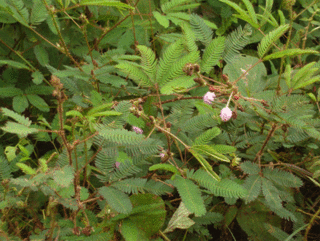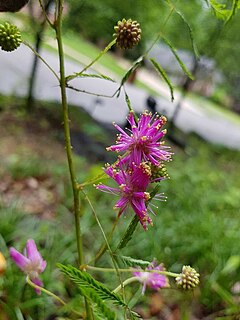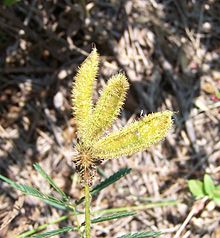
Robinia pseudoacacia, commonly known in its native territory as black locust, is a medium-sized hardwood deciduous tree, belonging to the tribe Robinieae of the legume family Fabaceae. It is endemic to a few small areas of the United States, but it has been widely planted and naturalized elsewhere in temperate North America, Europe, Southern Africa and Asia and is considered an invasive species in some areas. Another common name is false acacia, a literal translation of the specific name.

Senegalia greggii, formerly known as Acacia greggii, is a species of tree in the genus Senegalia native to the southwestern United States and northern Mexico, from the extreme south of Utah south through southern Nevada, southeast California, Arizona, New Mexico and western Texas to Baja California, Sinaloa and Nuevo León in Mexico. The population in Utah at 37°10' N is the northernmost naturally occurring Senegalia species anywhere in the world.

Rosa rubiginosa is a species of rose native to Europe and western Asia.

Rapid plant movement encompasses movement in plant structures occurring over a very short period, usually under one second. For example, the Venus flytrap closes its trap in about 100 milliseconds. The traps of Utricularia are much faster, closing in about 0.5 milliseconds. The dogwood bunchberry's flower opens its petals and fires pollen in less than 0.5 milliseconds. The record is currently held by the white mulberry tree, with flower movement taking 25 microseconds, as pollen is catapulted from the stamens at velocities in excess of half the speed of sound—near the theoretical physical limits for movements in plants.

Neptunia lutea, commonly called the yellow-puff, is an herbaceous plant in the legume family (Fabaceae). It is native to the United States, where it is primarily found in the South Central region, extending eastward into the Blackland Prairies of Alabama and Mississippi. Its natural habitat is in open areas such as prairies and savannas. It is tolerant of disturbed soil.

Cardamine hirsuta, commonly called hairy bittercress, is an annual or biennial species of plant in the family Brassicaceae, and is edible as a salad green. It is common in moist areas around the world.

Thigmonasty or seismonasty is the nastic response of a plant or fungus to touch or vibration. Conspicuous examples of thigmonasty include many species in the leguminous subfamily Mimosoideae, active carnivorous plants such as Dionaea and a wide range of pollination mechanisms.

Mimosa pigra, commonly known as the giant sensitive tree, is a species of plant of the genus Mimosa, in the family Fabaceae.

Mimosa diplotricha is a species of leguminous woody shrub native to the Neotropics. It is an invasive species and now has a pantropical distribution. It is commonly known as the giant sensitive plant, giant false sensitive plant, or nila grass.

Medicago polymorpha is a plant species of the genus Medicago. It is native to the Mediterranean basin but is found throughout the world. It forms a symbiotic relationship with the bacterium Sinorhizobium medicae, which is capable of nitrogen fixation. Common names include California burclover, toothed bur clover, toothed medick and burr medic.
This page provides a glossary of plant morphology. Botanists and other biologists who study plant morphology use a number of different terms to classify and identify plant organs and parts that can be observed using no more than a handheld magnifying lens. This page provides help in understanding the numerous other pages describing plants by their various taxa. The accompanying page—Plant morphology—provides an overview of the science of the external form of plants. There is also an alphabetical list: Glossary of botanical terms. In contrast, this page deals with botanical terms in a systematic manner, with some illustrations, and organized by plant anatomy and function in plant physiology.

Rosa moschata, the musk rose, is a species of rose which has been long in cultivation. Its wild origins are uncertain but are suspected to lie in the western Himalayas.

Mimosa aculeaticarpa is a species of woody shrub in the family Fabaceae. It is commonly known as the catclaw mimosa or the wait-a-minute bush, and is endemic to upland regions of Mexico and the Southwestern United States, particularly Arizona, New Mexico and Texas.

Mimosa turneri, the desert mimosa, is a perennial small- to medium-sized shrub native to the Southern United States and particularly abundant in Texas. It grows between 3.5 and 10 feet tall and produces pink flowers. In many places it is considered a weed because it can grow invasively in moist soils.

Inga thibaudiana is a species of tropical tree in the family Fabaceae. It occurs in Central and South America, where it is known as guaba de mono, guabito and guavo de playa.
Borthwickia is genus of flowering plants, containing one species, Borthwickia trifoliata from Yunnan, China and Myanmar. The common name in Chinese is 节蒴木. It is a shrub or small tree with evergreen trifoliate leaves, whitish flowers clustered at the tip of the branches, with many stamens, and thin, knobbly, drooping fruits with many small red seeds.

Zanthoxylum nitidum, commonly known as shiny-leaf prickly-ash, tez-mui or liang mian zhen, is a species of flowering plant in the family Rutaceae. It is a woody climber with prickles on the branchlets, thick, cone-shaped spines on the trunk and older branches, pinnate leaves with five to nine leaflets, and panicles or racemes of white to pale yellow, male or female flowers in leaf axils and on the ends of branchlets.
Helianthus nuttallii subsp. parishii is a subspecies of the species Helianthus nuttallii in the genus Helianthus, family Asteraceae. It is also known by the common names Los Angeles sunflower and Parish's sunflower. This subspecies has not been seen, in the wild or in cultivation, since 1937.

Mimosa microphylla, commonly called littleleaf sensitive-briar, is a species of flowering plant in the legume family (Fabaceae). It is a perennial herb native to North America, where it is found primarily in the southeastern United States. Its typical natural habitat is in dry woodlands and forests, although it can also be found in disturbed areas.

Mimosa quadrivalvis, known as fourvalve mimosa, sensitive briar and cat's claw, is a trailing vine native to North America, Central America, and the Caribbean. It is known as sensitive briar because the leaves fold when they are touched or disturbed.


















